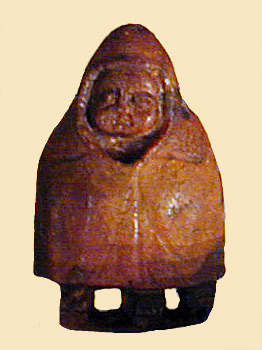
cucullus

The cucullus was a funnel-shaped (see Martial's concern that his book of poems will become a cucullus for incense or pepper Epigrammata 3.2.5) and brimless head-covering. It could be worn open or closed at the neck as a separate item of clothing (see Martial, Epigrammata 14.140, for the cucullus liburnicus, a green hood whose color bled into the wearer's white lacerna) or attached to a cloak or a cape, used by travellers, shepherds and other outdoor laborers, as well as soldiers on duty in cold climates (see image below).
Umbricius names the wearing of the lacerna and cucullus, presumably over only the tunica, one of the pleasures of living simply in the country, opposing it to the urban garment, the toga. He describes the cucullus as duro, coarse or thick, for warmth, and veneto, either because of its bluish-green color (in Epigrammata 10.76.8, Martial speaks of the pullo...cucullo) or because it originated among the northern tribe of the Veneti.
In the city, whenever possible, the hooded, dark-colored lacerna was worn in bad weather at outdoor events to protect the toga, or at night by those wishing to conceal their identity (see Juvenal, Saturae 6.118, 330: nocturnos ... cucullos). Elsewhere Juvenal refers to the Celtic origin of the hood (Satonico ... cucullo: Saturae 8.145). Martial mentions the bardocucullus, a hooded overcoat of heavy oily wool, which was good protection from the rain and probably came from Illyria (see Epigrammata 14.128).
